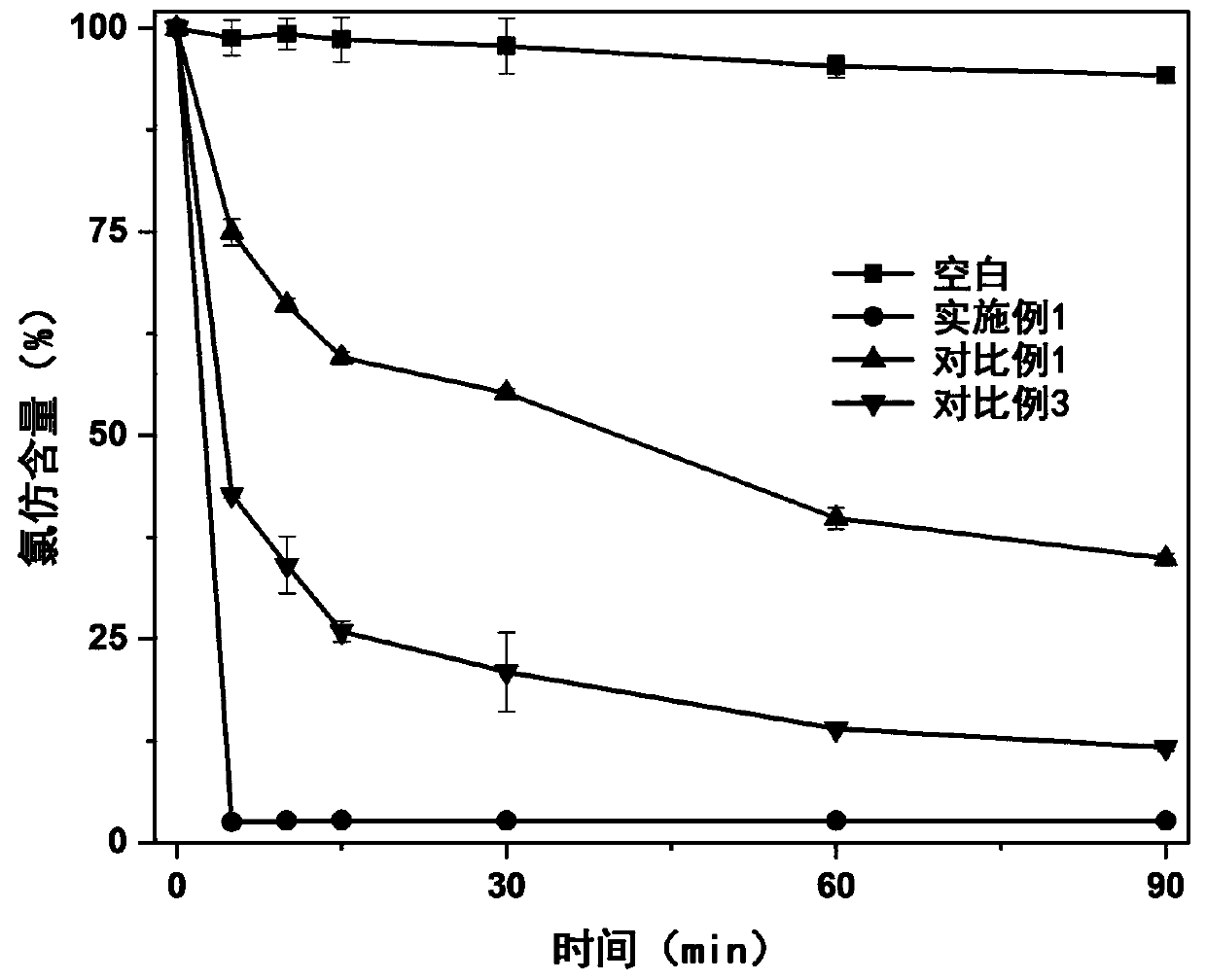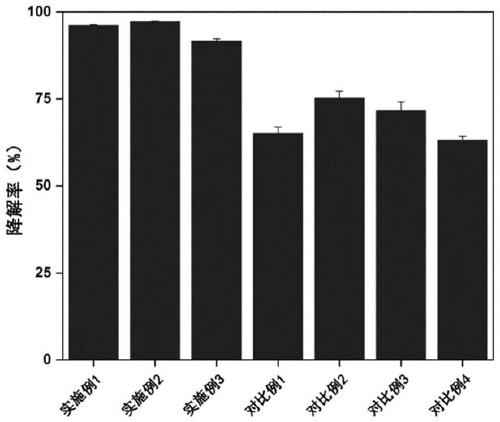Method for degrading open-chain hydrochloric ether through tannic-acid-stable-nanoscale-zero-valent-iron-reinforced persulfate
A technology of open-chain chlorinated hydrocarbons and persulfates, applied in chemical instruments and methods, oxidized water/sewage treatment, water pollutants, etc., can solve problems such as limiting applications and affecting the strengthening effect of persulfates, so as to reduce secondary Generation of high-grade by-products, excellent reaction effect, and fast reaction efficiency
- Summary
- Abstract
- Description
- Claims
- Application Information
AI Technical Summary
Problems solved by technology
Method used
Image
Examples
Embodiment 1
[0034] Example 1 Tannic acid-stabilized zero-valent iron strengthens sodium persulfate to degrade chloroform-containing water samples
[0035] Take nano-scale zero-valent iron stabilized by sodium persulfate and tannic acid, add it to a chloroform (CF) solution with an initial concentration of 20mg / L, close the reaction environment and set the speed of the water bath shaker to 120r / min, and react for 90min. Wherein, zero-valent iron and sodium persulfate mol ratio (mol Fe / PS) is 2, and the molar percentage (mol%TA / Fe) of tannic acid and zero-valent iron is 0.33; The mol ratio of sodium persulfate and chloroform is 50 ;
[0036] Before adding persulfate, the pH value of the aqueous solution was 8.0;
[0037] After starting the reaction, use a 5mL syringe to extract 2mL of the reaction solution at a fixed time interval each time, add methanol to quench the reaction immediately after taking it out, place the 5mL centrifuge tube containing the sampling solution on a strong magnet...
Embodiment 2
[0040] Example 2 Tannic acid-stabilized zero-valent iron strengthens sodium persulfate to degrade chloroform-containing water samples
[0041] Take nano-scale zero-valent iron stabilized by sodium persulfate and tannic acid, add it to the CF solution with an initial concentration of 20 mg / L, close the reaction environment and set the speed of the water bath shaker at 120 r / min, and react for 90 min. Wherein, mol Fe / PS is 2, and mol% TA / Fe is 0.66; The mol ratio of sodium persulfate and chloroform is 50;
[0042] Before adding persulfate, the pH value of the aqueous solution was 8.0;
[0043] After starting the reaction, use a 5mL syringe to extract 2mL of the reaction solution at a fixed time interval each time, add methanol to quench the reaction immediately after taking it out, place the 5mL centrifuge tube containing the sampling solution on a strong magnet, and use magnetic force. Magnetic nano-scale zero-valent iron particles, then suck out the upper layer solution, filt...
Embodiment 3
[0046] Example 3 Tannic acid-stabilized zero-valent iron strengthens sodium persulfate to degrade chloroform-containing actual water samples
[0047] Add to the actual water sample containing CF pollution with an initial concentration of 78.55mg / L (the water sample was collected from a polluted plot site in Tianjin, the main pollutant in the water sample is chloroform, and various organic substances interfere at the same time), seal Reaction environment and set the rotation speed of the water bath shaker at 120r / min, and react for 90min. Wherein, mol Fe / PS is 3, and mol% TA / Fe is 0.66; The mol ratio of sodium persulfate and chloroform is 20;
[0048] Before adding persulfate, the pH value of the aqueous solution was 8.0;
[0049] After starting the reaction, use a 5mL syringe to extract 2mL of the reaction solution at a fixed time interval each time, add methanol to quench the reaction immediately after taking it out, place the 5mL centrifuge tube containing the sampling solu...
PUM
 Login to View More
Login to View More Abstract
Description
Claims
Application Information
 Login to View More
Login to View More - R&D
- Intellectual Property
- Life Sciences
- Materials
- Tech Scout
- Unparalleled Data Quality
- Higher Quality Content
- 60% Fewer Hallucinations
Browse by: Latest US Patents, China's latest patents, Technical Efficacy Thesaurus, Application Domain, Technology Topic, Popular Technical Reports.
© 2025 PatSnap. All rights reserved.Legal|Privacy policy|Modern Slavery Act Transparency Statement|Sitemap|About US| Contact US: help@patsnap.com


